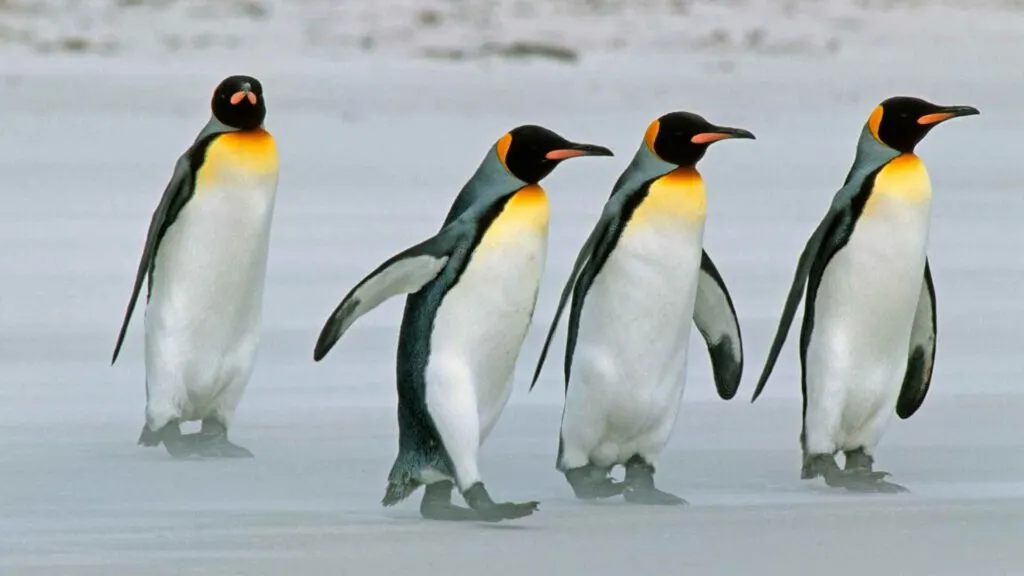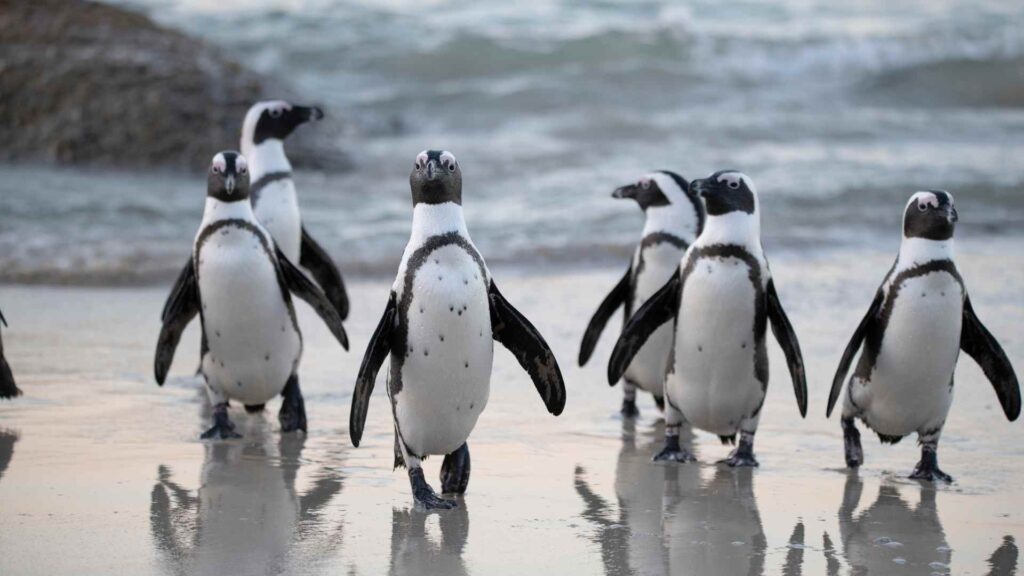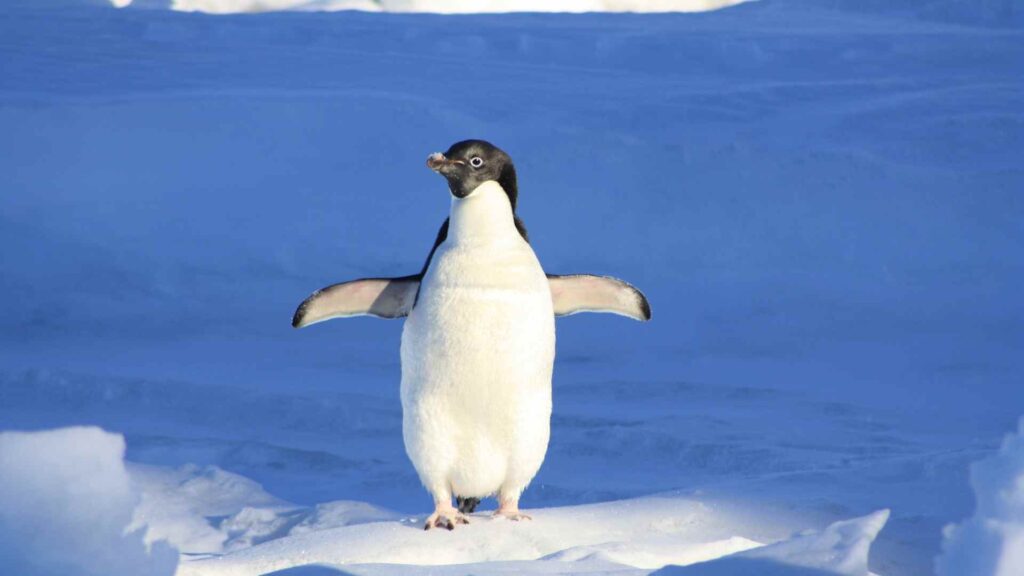Penguins are some of the most fascinating and beloved animals on Earth. Known for their adorable waddles and striking black-and-white “tuxedos,” penguins have captivated people of all ages.
Dive into this ultimate guide of penguin fun facts and learn about their habitats, adaptations, social lives, and much more!
Penguin Anatomy
- Penguins have specialized feathers that keep them warm and waterproof.
- They use their wings as flippers, adapted perfectly for swimming.
- Most penguin species have counter-shaded plumage – black backs and white bellies – to camouflage in the water.
- Unlike other birds, penguins cannot fly, but they are exceptional swimmers.
- Penguins’ bones are denser than those of flying birds, helping them dive deeply.
- Their eyes are adapted for underwater vision, making them excellent hunters.
- Penguins have an extra gland near their eyes that helps them excrete excess salt from seawater.
- Their body fat helps them survive cold environments and keeps them buoyant.
- Penguins have a unique set of vocalizations for communicating with each other.
- Most species have short, stiff tails that help with balance while walking.
- Penguins’ beaks vary in size and shape depending on their diet.
- They molt all their feathers at once, a process called “catastrophic molting.”
- The structure of their wings is similar to those of other birds but is adapted for swimming rather than flying.
- Each penguin has a unique feather pattern on its face, like a human fingerprint.
- Their muscles contain high levels of myoglobin, allowing them to hold their breath underwater for long periods.

Habitat and Distribution
- Penguins are only found naturally in the Southern Hemisphere.
- Most penguin species live in colder regions, but some thrive in warmer climates.
- Emperor penguins are the only penguins that breed on Antarctica’s ice sheets.
- Galapagos penguins are the only species found north of the equator.
- Penguin colonies can be as large as hundreds of thousands of individuals.
- Penguins typically live along coastlines, where they can access food.
- They have adapted to both icy and temperate habitats depending on the species.
- Some penguins build nests on rocky islands or beaches, using pebbles and stones.
- The densest populations of penguins are found in the sub-Antarctic islands.
- Many penguins rely on stable ice for hunting and breeding, making climate change a threat.
- Penguins have migration routes specific to each species, some traveling hundreds of miles.
- Penguins often share habitats with other birds and animals, like seals and seabirds.
- Coastal regions are preferred for breeding due to access to food.
- Penguins are highly territorial about their chosen nesting or breeding grounds.
- Penguins are seen as indicators of ocean health, with many living near rich fishing areas.
Penguin Breeding and Parenting
- Emperor penguins are known for their unique courtship rituals and bonding behaviors.
- Male penguins often “propose” by presenting a pebble to a female.
- Both parents are typically involved in incubating the egg and feeding the chick.
- Penguins can recognize their mate and chick’s vocalizations even in large colonies.
- Emperor penguins breed during the Antarctic winter, facing extreme conditions.
- After laying an egg, the female often goes to sea to feed while the male incubates.
- Penguin chicks are covered in fluffy down feathers, which they shed as they mature.
- Adelie penguins build pebble nests to keep their eggs off the cold ground.
- Chinstrap penguins are known for their loud calls during the breeding season.
- Penguins may form lifelong pair bonds, but this depends on the species.
- If an egg is lost, penguins might try to “adopt” a nearby egg or chick.
- After hatching, penguin chicks are protected in crèches – groups of young chicks.
- Gentoo penguins usually lay two eggs and often raise two chicks.
- Penguin parents take turns feeding, often traveling long distances to find food.
- Penguin chicks rely on their parents for food until they are strong enough to hunt.

Diet and Hunting Techniques
- Penguins primarily eat fish, krill, and squid, depending on their habitat.
- Penguins can dive to impressive depths to catch their prey.
- Their hunting is aided by excellent underwater vision and agility.
- Penguins swallow their food whole, and their tongues have backward-facing spines to grip slippery prey.
- Some species can stay underwater for over 20 minutes while hunting.
- Penguins have streamlined bodies and strong flippers, which make them swift swimmers.
- They rely on cooperative hunting, especially in large colonies.
- Penguins have a high metabolic rate to maintain body warmth, so they need to eat frequently.
- Different species have different hunting depths; Emperor penguins dive deepest.
- Penguins often follow the migration patterns of their prey.
- They can “porpoise” or leap out of the water while swimming to breathe.
- Penguins are opportunistic feeders, consuming whatever is most accessible.
- They can adjust their diet based on availability, which is critical during breeding.
- Penguins often gather in groups called “rafts” when hunting for protection.
- Penguins’ hunting patterns are affected by changes in ocean temperatures and fish populations.
Unique Penguin Behaviors
- Penguins have a waddle-like gait due to their short legs and webbed feet.
- Some penguins slide on their bellies, a behavior known as “tobogganing.”
- Penguins greet each other by bowing, vocalizing, or preening.
- Penguins huddle together for warmth, especially during extreme cold.
- They communicate with complex vocalizations, which help in large colonies.
- Penguins can “surf” waves to get onto the shore after a hunting trip.
- Some species perform “ecstatic displays” during mating season, flapping their wings and calling.
- Penguins often engage in playful interactions, showing social intelligence.
- They preen their feathers with oil secreted from a gland near the base of their tail.
- Penguins are highly curious and often investigate new objects or animals.
- Some penguins mate for life, displaying loyalty to their partners.
- Penguins have distinct “grooming” behaviors to strengthen pair bonds.
- Groups of penguins sometimes synchronize movements to intimidate predators.
- Penguins spend hours each day maintaining their feathers to stay waterproof.
- Some penguin species have unique “head-bobbing” rituals to show dominance.
Penguins and Climate Change
- Penguins are vulnerable to climate change, especially species that rely on ice.
- As temperatures rise, ice melt threatens the Emperor penguin’s breeding grounds.
- Warming seas impact food availability, affecting penguin diets.
- Pollution, like oil spills, can be catastrophic for penguin colonies.
- Penguins are sensitive to changes in sea ice, which affects their hunting areas.
- Rising ocean temperatures can disrupt the krill population, a primary food source.
- Climate change affects migration and breeding patterns for many penguin species.
- Overfishing also reduces the fish stocks penguins rely on.
- Ocean acidification impacts the shellfish that penguins eat.
- Penguins are often used as indicators of ecosystem health.
- The spread of diseases increases as temperatures rise, threatening penguin populations.
- Loss of habitat affects penguin breeding success and chick survival.
- Conservation groups closely monitor penguin populations to gauge climate impacts.
- Penguins depend on predictable ice cycles, which are now shifting.
- Some species may face extinction if global temperatures continue to rise.

Famous Penguin Species
- Emperor penguins are the tallest and heaviest of all penguin species.
- King penguins resemble emperors but are slightly smaller and live in warmer areas.
- Gentoo penguins are known for their red-orange beaks and white eye patches.
- Chinstrap penguins are famous for the black line under their chin.
- Little Blue penguins, the smallest species, are also called fairy penguins.
- The Adelie penguin has a white ring around its eyes and is highly vocal.
- Macaroni penguins have distinctive yellow-orange feather crests.
- Rockhopper penguins are famous for their bright yellow crests and feisty nature.
- The Magellanic penguin lives along the coasts of South America.
- Humboldt penguins are named after the Humboldt Current they inhabit.
- Galapagos penguins are the rarest and only found in the Galapagos Islands.
- Fiordland penguins are native to New Zealand’s coastal regions.
- Yellow-eyed penguins are known for their striking yellow eyes and rarity.
- Snares penguins are unique to New Zealand’s Snares Islands.
- African penguins are also known as “jackass” penguins for their donkey-like bray.
Evolution and Adaptations
- Penguins are believed to have evolved from flying birds millions of years ago.
- Their bodies adapted over time to be efficient swimmers rather than fliers.
- Penguins evolved in cooler waters, allowing them to develop dense feathers.
- Fossils show ancient penguins were much larger than modern ones.
- The shape of their beaks evolved based on their dietary needs.
- Penguins have adapted to store large amounts of oxygen for diving.
- Their unique bone density helps them withstand water pressure.
- Penguins’ feet are adapted for both swimming and walking on land.
- Their blubber layer keeps them warm in frigid waters.
- Penguins evolved counter-shading for underwater camouflage.
- The unique shape of their wings allows for powerful propulsion.
- Penguins’ circulatory systems help retain body heat.
- Adaptations in penguin vision improve clarity underwater.
- Some species have evolved to thrive in warmer climates.
- Penguins developed social behaviors that aid survival in colonies.
Penguins in Pop Culture
- Penguins have been featured in movies like “Happy Feet” and “March of the Penguins.”
- Pingu, the claymation character, is a beloved penguin icon.
- The “Penguins of Madagascar” movie made them popular with kids.
- Sports teams, like the Pittsburgh Penguins, are named after penguins.
- Penguins are featured in many nature documentaries.
- Skipper, Kowalski, Rico, and Private are popular animated penguin characters.
- The character Chilly Willy was a classic cartoon penguin.
- Many zoos have penguin exhibits that attract large crowds.
- Penguins have become symbols of environmental conservation.
- They are often used in commercials to represent cuteness and humor.
- Penguin characters are common in video games and kids’ toys.
- Some penguins are social media stars, with their antics shared widely.
- Penguins are often used in art, from illustrations to sculptures.
- Penguins are beloved by both kids and adults around the world.
- Antarctic research stations have made penguins famous in scientific circles.
Conservation and Threats
- Overfishing threatens food sources for penguin species.
- Many penguins face dangers from plastic pollution.
- Oil spills have caused mass deaths in some penguin colonies.
- Habitat loss due to human activity affects many penguin populations.
- Penguins are vulnerable to invasive predators, like rats and cats.
- Poaching was once a serious threat, especially for eggs.
- Some penguin species are critically endangered.
- Disease outbreaks can devastate large colonies.
- Penguins are often caught accidentally in fishing nets.
- Conservation groups work to protect penguin habitats.
- Marine protected areas help safeguard penguin food sources.
- Ecotourism is regulated to prevent disruption to penguin colonies.
- Climate advocacy is vital for penguin survival.
- Penguins are indicators of ocean health and climate stability.
- Continued conservation is key to penguins’ long-term survival.
Bonus Fun Facts About Penguins
- Penguins are one of the few bird species that are monogamous.
- Each penguin species has a unique vocal sound.
- Penguins have a sense of smell, used for finding food.
- They are highly social animals, often seen in large groups.
- Penguins don’t have external ear structures but hear well.
- The name “penguin” comes from the Welsh word “pen gwyn.”
- Penguins can drink seawater thanks to a special gland.
- Some penguins can travel up to 30 miles per hour in the water.
- Penguins’ knees are hidden beneath their feathers.
- A group of penguins on land is called a “waddle.”
- In water, a group of penguins is called a “raft.”
- Some penguins can leap several feet in the air.
- Penguins’ feathers are unique in texture and density.
- Penguins often mate in the same area every year.
- The Galapagos penguin is the most endangered penguin species.
- Penguins are found on every continent in the Southern Hemisphere.
- Baby penguins are called “chicks” or “hatchlings.”
- Penguins have excellent memory for visual patterns.
- Penguins’ eyes turn blue under certain lighting conditions.
- The largest penguin fossil found was over 5 feet tall.
- Penguins walk an average of 75 miles each breeding season.
- Some penguins live up to 20 years in the wild.
- Penguins have inspired countless conservation movements.
- Penguins are iconic symbols for various brands.
- Penguins often mimic each other’s behaviors in groups.
- Emperor penguins can lose up to half their body weight in one breeding season.
